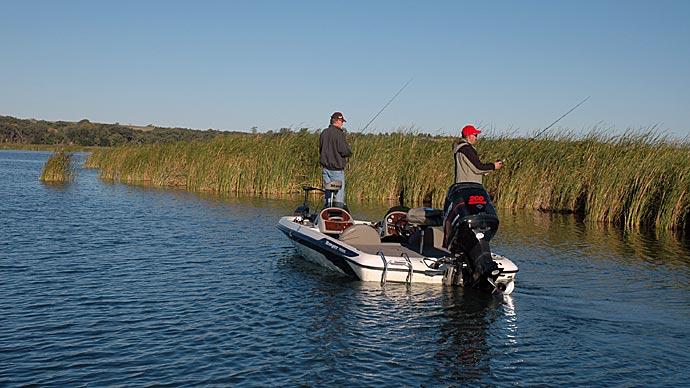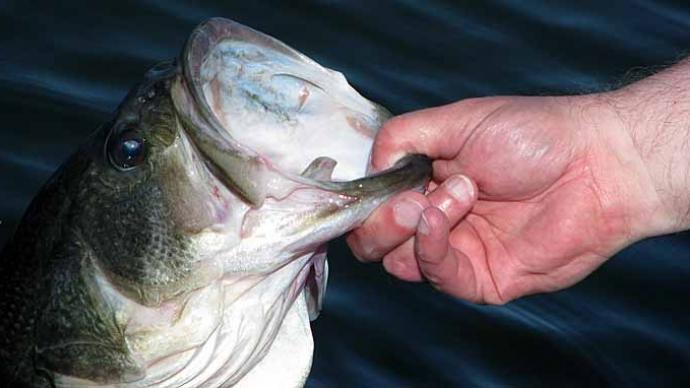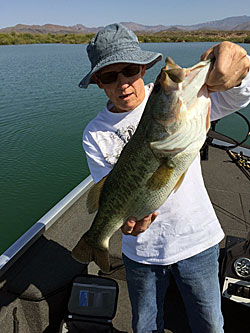
The Carolina rig is a favorite with tournament pros because you can cover a lot of water while keeping the presentation subtle. If you want to, you can slow down and finesse it around a rock or a stump or quickly drag it down a point. You can even pop a Carolina rig down a cliff or finesse it through heavy cover. The Carolina rig has you covered in various situations: shallow to deep, fast to slow, tiny bait to giant plastics.
First, the Carolina rig is a weight, a swivel, and a leader. The length of the leader varies – I’ve known guys who fish with a 4-inch leader one day and a 4-foot leader the next. The general rule of thumb is the tougher the bite, the longer the leader. The weight also varies greatly, and egg sinkers are popular. Some guys put a bead between the swivel and the weight because the knot can get damaged by the weight smacking into it over and over. The rule I use with weights is easy: the deeper I’m fishing, or the heavier the cover, the bigger the weight. You have to be able to get to the bottom, and you also need to be able to feel the rig once it’s down there.
Tip #1 – Gear for big weights
Bass Fishing Hall of Famer Mike Folkestad recommends a high-speed reel and a reasonably stout rod for Carolina rig fishing, especially with heavy weights. You need the power to get hooksets on deep, heavy rigs and speed to get the fish to the boat without giving him any slack. A 6’6” medium heavy rod is ideal for 3/8- to 1-ounce weights, and you can use 15-pound-test line. A lot of fishermen use slightly lighter lines for the leader.
Tip #2 – Gear for light weights
You may think that you are just split-shotting if you fish a Carolina rig with light weights. This isn’t true because, in a Carolina rig, the weight slides freely, so when the fish picks up the bait, he often doesn’t even know the weight is there. Folkestad uses a medium-action spinning rod when fishing in shallow water, clear water, or under tough conditions. He’ll use a 3/16-ounce mojo weight as a standard, moving up and down.
Tip #3 – Bait size
If you’re fishing crystal clear water or super tough conditions, go with a smaller bait like a small Yamamoto grub, a reaper, or a 4-inch lizard or Senko. Size your hooks accordingly. When you’ve got a limit, or the fishing is good, break out the big baits – six inches or more to try for a kicker.
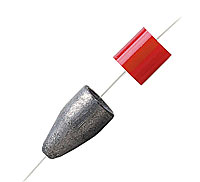
Tip #4 – Terminal Tackle
Most of the time, a barrel swivel is used for Carolina rigs, but a Carolina Keeper is a small cylinder with a slit in the center that you can use instead of a swivel. You squeeze the Keeper with your needle nose pliers – keep the slit perpendicular to the pliers' jaws - and squeeze until the slit opens enough for the line to go through. Slide it on the line without letting go of the pliers until it is in place. Slide the weight on the line first, then the Keeper. This makes your Carolina rig adjustable. Just squeeze it open before moving it up or down the line.
Tip #5 – Hooks
Go with the lightest wire hook you can get away with for the size of the bait you are using. The whole point of a Carolina rig is that the bait flutters and floats around behind the weight. When you pull the rig, the bait jerks forward, then it begins to drift down when you stop moving it. A thick wire hook makes the bait sink too fast, so use a good but light hook.

Tip #6 – Leader length
This is the big question. How long should your leader be? I’ve seen guys fish a leader as long as 5 feet and as short as 2 inches. The short answer is the tougher the bite, the longer the leader. Also, the leader needs to take the cover into account. If you are fishing an area with thick weeds and want your lure to run over the top, make sure your leader is long enough to allow for that. A slightly shorter leader is easier to use if you’re fishing a lot of trees – use a two-foot leader and bring the weight right up to the tree, inch it up, then shake it a couple of times and give it some slack as it falls down the near side of the tree. This is one of the few instances where you’ll feel a fish just hammer a Carolina rig.
Tip #7 – The bite
Most of the time, you won’t feel a bite on a Carolina rig. The fish will just be there – you’ll feel the weight when you try to move the rod, or the fish may tug back. Set the hook instantly – don’t give him a chance to drop the bait.
Tip #8 – Technique
The best way to fish a Carolina rig is to drag it on the bottom. You don’t need to hop it around or lift it at all. You can throw the rig a long way with a big stout rod and a heavy weight. Keep your spool open until the rig hits bottom, then just take up the slack. Once the line is taut, move the Carolina rig by pulling the rod to the side, keeping the weight on the bottom. When you’ve pulled as far as you can, return the rod to the original position, reeling up the slack as you go. You should end up with a taut line again. Just keep doing that over and over until you need to re-cast. At some point, when you go to pull the rod to the side, it will feel heavy – like you’ve hooked a rubber band. When that happens, set the hook!
Tip #9 – Hookset
Setting the hook requires a lot of power with a lot of line out and that heavy weight. One thing I learned in martial arts applies here: speed is power. The instant you feel that heaviness, you set the hook hard by turning your body and jerking the rod to the side simultaneously. Keep reeling hard, so you don’t give the fish any slack. Now is when having good sharp hooks and a good line pays off.
Tip #10 Line
Mono is not the best choice for a Carolina rig unless you choose something without a lot of stretch – like Berkley Big Game. 15-pound-test Big Game is an excellent Carolina rig line. A lot of guys also use fluorocarbon or braid. You should experiment with different lines and stick with the one that suits your style. I use Big Game because I hate braid and never use it for anything, and I don’t think I need the expense of fluorocarbon when the 15-pound Big Game works so well. If the bite is super tough or you’re fishing shallow or clear water, a fluorocarbon leader might be the ticket.
Tip #11 Where to fish
The Carolina rig is an excellent bait for covering water. It’s not usually as fast as a crankbait or spinnerbait, but it can cover water quickly, even when fishing deep. Go to a point and fan cast it like you would a crankbait. Fish them down points, along ledges, down the center of cuts, over and around humps, and even down cliffs – I know a guy who uses a 4-inch leader and a craw and bounces that thing down cliffs. He catches many fish that way, and it’s a dynamite way to figure out how deep they are.
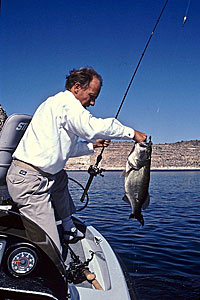
Tip #12 Baits
The king of the Carolina rig baits in Arizona’s reservoirs is a green lizard. Guys have been catching giant limits on that bait for decades, literally. When the fish are finicky, we go to reapers or grubs. There are also a lot of great floating baits out there, like the ones at necotackle.com. A floating bait puts a new twist on the Carolina rig because it never sinks back to the bottom. Instead, it darts forward, stops, and down and forward again. These baits can be killer, especially on muddy bottoms or where the bottom is covered in grass or weeds.
Tip #13 Weights
The egg sinker is cheap and effective for Carolina rigs and comes in various sizes. People also use cylindrical mojo weights and regular old bullet sinkers as well. The key is to use the heaviest weight you can get away with so you’re not wasting a ton of time waiting for the darn thing to hit bottom. An Arizona man named Rob Vanderkooi used just to slay them on Carolina rigs all the time. I’m talking 42 pounds for six fish limit! He told me a rule of thumb: for fishing 8-12 feet deep, use a ½-ounce weight. Over that, use ¾. He kept his leaders at 4 to 5 feet long and fished slowly. He’d fish as deep as 40 feet first thing in the morning when everyone else was throwing topwater.
The Carolina rig is an old-school technique, but it is one of the most versatile rigs. Next time the fish in your neck of the woods, get lockjaw, tie one on, and see what happens.


